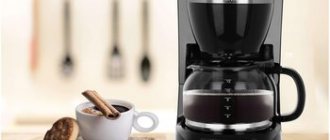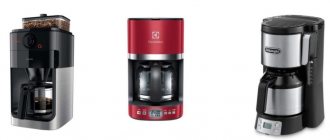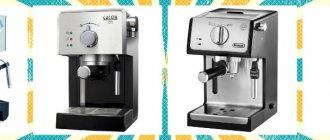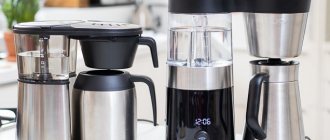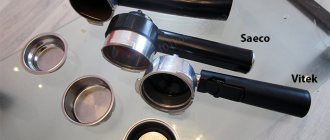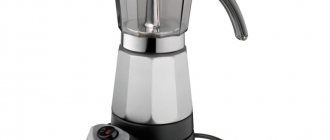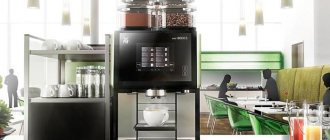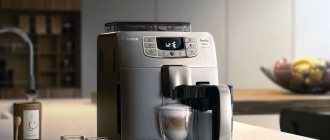A drip coffee maker is an electric device for preparing filtered coffee using the pour or percolation method. Drip-type coffee makers have been produced for a long time, but even today they feel confident among the advanced coffee machines of the new generation. What is the secret of their popularity, what are the pros and cons, and which models can be called the best in class?
Drip coffee maker - what is it?
The drip coffee maker has a solid history. For the first time, a device that prepared coffee by straining hot water through ground powder was brought to the attention of the public back in 1800. The inventor of the method is a church minister, Parisian Archbishop Jean-Baptiste de Bellois. The invention was modernized, redesigned, and patented many times in different countries. But the principle remained the same. With the evolution of electrical appliances, the drip coffee maker acquired its own heating source and acquired the appearance we are familiar with.
Today's drip machine is an electric device with a heater in which hot water passes through a filter containing ground coffee and enters a reservoir. The strength and aroma of the drink is achieved through the slow passage of water through the coffee, during which it is enriched with the taste and aroma of the ground beans.
Is it possible to brew tea in a coffee maker?
Although it is strange, tea can be brewed in drip coffee makers. The drink in this device is brewed even faster than in a conventional kettle. It is more efficient to brew loose leaf tea because the water flows freely through the leaves. A capsule coffee maker will help keep your drink warm much longer than a kettle.
How to brew tea in a coffee maker?
In order for the tea to turn out delicious the first time, you need to follow some rules:
- Pour half a glass of vinegar and water into the heating tank of the device until the container is full. Pass the liquid through the apparatus. This is necessary to eliminate the coffee smell;
- To get rid of the vinegar smell, you need to run clean water through the coffee maker;
- Next you need to do everything as usual. Just instead of coffee, put tea in the filter;
- The amount of tea brewed depends on its type and the desired final amount of the drink.
Useful tips for making tea in a drip coffee maker
If the coffee maker will brew tea bags rather than loose leaf tea, then the bags should be folded into a neat pyramid. This is necessary for the uniform passage of water through the tea. To prepare a cold drink, you need to make the brew stronger than usual. Next, pour the tea into a tempered glass vessel, add water and pieces of ice.
If your family members like to brew both tea and coffee in a coffee maker, then it would be ideal to have two coffee makers for these purposes. This way you can avoid the coffee smell in your tea.
Very often girls are interested in whether pregnant women can drink green tea . This drink is very healthy, so even pregnant women should drink it. The main thing is not to overuse tea, because it will not lead to anything good.
When using tea bags when brewing, you need to make sure that the strings from them do not get into the filter. They can be gently pressed with the lid of the coffee maker.
Brewing tea in a coffee maker is most suitable for herbal teas as they need to steep longer.
After preparing the drink, you should be careful because the brewed tea and the glass coffee pot may have a high temperature.
Can I brew tea in other coffee makers?
In other coffee makers, tea is brewed using the same principle. For example, in an electric espresso machine, the tea is placed in a filter basket. A geyser coffee maker is also ideal for brewing tea. You just need to replace coffee with tea and enjoy the aromatic and healthy drink.
Source: https://gurman-bel.ru/mozhno-li-v-kofevarke-zavarivat-chaj/
Device
Drip coffee makers are produced by many manufacturers, but the key elements are the same for all devices. Let's look at the basic nodes.
- Cold water reservoir. It is often non-removable and is located at the back.
- A tank or boiler in which heating occurs.
- A heating element.
- Funnel and filter for ground coffee. The funnel in some machines is removable. The filter is self-contained and can be disposable or for regular use.
- Container for ready-made coffee. It can be made in the form of a flask, a coffee pot, and sometimes ordinary cups play this role.
Scheme of work
The principle of operation of a drip coffee maker is a special filtering of coffee - water is passed through ground beans, which are located in a special filter. The coffee pot itself consists of two compartments: cold water is poured into a glass reservoir, and ground beans are poured into a container with a filter, called a “brew unit”. After loading all the ingredients, the start button is pressed and the brewing process begins.
Cold water flows down to a heater located at the bottom of the coffee maker. When heated, steam is formed, which subsequently rises through special tubes to the brewing unit. And there the brewing process already takes place. The temperature in the coffee compartment is slightly lower and the steam turns into condensation. Thanks to this effect, the finished coffee flows drop by drop into the coffee pot.
You can see the principle of operation of the device in the presented video.
Some models of drip coffee makers are equipped with an auto-heating function. Thus, the prepared coffee will remain hot for a long time.
Operating principle of a drip coffee maker
Its operating principle has changed little over the past two centuries, although the device has acquired a modern appearance and some additional functions.
- Water from the reservoir, which is usually located at the back, enters the boiler.
- In the tank, the water heats up and rises up the tube.
- Drop by drop it flows through the thickness of the coffee powder and falls into the lower compartment.
- When all the water is heated and drips through the filter, the coffee is ready.
The coffee grounds remain in the filter and do not stain the cups, and the platform on which the tank with the finished coffee is installed can have a heating function and maintain the temperature of the drink.
Despite the similarity, coffee makers from different manufacturers differ in design, volume, materials, and power. The most differences are observed in additional functions: the presence or absence of auto shut-off, delayed start timer, indication, mechanical or electronic control.
Common faults
Some breakdowns can be repaired independently. In difficult situations, you need to contact a workshop. Typical problems with coffee makers can be seen in the table:
| Symptom of malfunction | Cause | How to fix |
| The coffee maker does not turn on. |
|
|
| The heating element heats up, but water does not enter the flask. |
|
|
| The counter of used filters is faulty. |
|
|
| Particles of ground coffee enter the receiving flask of the coffee maker. | The rocker arm is not inserted correctly or is deformed. | Fix or replace. |
How to use a drip coffee maker
It’s not for nothing that a drip coffee maker is considered one of the simplest and most reliable coffee devices in the world. You can literally use it with your eyes closed.
- Connect to the network.
- Pour water into the tank to the desired level.
- Place coffee in the filter in the proportion specified in the instructions. Approximately a heaping teaspoon for every 100 ml of liquid.
- Close the filter. Place a container for the finished coffee.
- Press the power button.
- Wait for all the water to flow in the form of coffee into the tank.
- Turn it off.
- Pour coffee into cups.
Once the appliance has cooled down, the disposable filter with coffee grounds can be simply disposed of. Reusable - remove grounds, rinse and dry.
Which coffee maker is better - carob or drip?
Budget carob and drip models have approximately the same price, so the first thing that is taken into account is functionality.
If you choose a simple model for all family members, choose a drip model. But you have to come to terms with the fact that she can only prepare regular black coffee - Americano.
A carob coffee maker is chosen by those who like drinks stronger or with milk foam. The cappuccino maker in them prepares lattes, cappuccinos and other drinks that require frothed milk. When you have such a coffee maker in your arsenal, you can safely try on the role of a barista. True, carob equipment is more difficult to care for.
Both options have their strengths and weaknesses. Therefore, when deciding on a model, you should take into account your own preferences. Drip coffee makers do a good job of preparing regular black coffee in large quantities. Lovers of various tastes choose carob models.
Peculiarities
What should people who are thinking about buying a drip coffee maker know?
The device will prepare you only one type of coffee - natural black filtered coffee. Some call this type “Americano” because this is what you will be offered in any coffee shop in the United States. The drip coffee maker cannot prepare espresso, cappuccino, or oriental coffee. The strength of the finished drink will most likely be average. Although you can increase the strength by taking finely ground coffee and a small portion of water.
Usually, for a drip coffee maker, medium and strong roasted beans are taken, medium grind.
This device is very popular in North America, but in Europe it is much less favored, giving preference to coffee machines and carob coffee makers that prepare a richer drink.
In terms of ease and reliability of use, this is the undisputed leader.
pros
- Simplicity and reliability of design.
- Trouble-free operation.
- Ease of Management.
- Reasonable price.
- Prevalence and accessibility.
- Coffee of stable quality.
Minuses
- One recipe.
- The delicate aroma and taste of elite coffee varieties is lost.
- Many similar models.
Reviews
Real owners are ready to share with our readers their impressions and experience in operating devices from different manufacturers.
Vitalina, 42 years old, owner of VITEK VT-1503
— I bought a coffee maker quite recently, to replace an old one. I was used to drips and wanted the same one. I chose this one because of its low price, familiar design, and heated platform. Quite happy with the purchase. It makes excellent coffee, doesn’t smell like plastic, and has been working for 2 years almost without a break. She got her money's worth a long time ago!
Anna, 36 years old, owner of PHILIPS Daily Collection
— Gave it to work colleagues for their last birthday. Convenient coffee pot with a good handle. Disposable filters, on the one hand, are convenient - you don’t need to get dirty, but on the other hand, there are additional costs, which is not very pleasant. There is a drawback - the prepared coffee splashes a lot. Maybe my marriage is like this? In general, I didn’t use it myself, I gave it to my husband at the office. It suits him.
Andrey, 28 years old, owner of MAXWELL MW-1650
— To be honest, I chose it because of the price. But I didn’t regret it. Brews coffee normally, convenient reusable filter, heats the flask so it doesn’t get cold. It works quickly, enough for 4 cups - very convenient for family use. My brother, however, doesn’t like that the coffee is not scalding, but just hot. But you can't please everyone!
Irina, 31 years old, owner of TEFAL CM
— A good model, holds more than a liter of coffee. I bought it precisely because of its spaciousness for a large family. Cooks quickly and doesn't spill anything. No permanent smells or tastes. The only negative that was noticed after six months of use is that it is inconvenient that there is no indicator. It is not clear whether it is on or off.
Filters for drip coffee makers
An important point when choosing coffee makers is the type of filter. There are two options.
- Reusable.
- Disposable.
Reusable
Comes included. It is a removable funnel-strainer, usually made of plastic and nylon. A more expensive and “sophisticated option” is a filter with a metallized coating, which is applied to the same nylon.
The advantage of such a filter is that there are no additional costs.
The downside is that you need to clean the filter after each use.
Disposable
Such a filter has a significant advantage - you don’t need to bother with waste coffee grounds. After the drink is prepared, the filter element along with all its contents can simply be thrown away.
The biggest disadvantage of such filters is that they become a constant cost item. Even if when purchasing a coffee maker a certain supply is attached to it, sooner or later they will run out.
Disposable filters vary in size. Cellulose is usually used to make them.
- Unprocessed. Brown in color, no bleaching compounds are used in its production. Considered the most environmentally friendly option.
- Bleached. White bleached cellulose filters. Previously, chemical compounds were used in production, now they are bleached with oxygen.
Sometimes you come across filters made from bamboo fibers, but in essence they are the same cellulose, only they are more expensive.
The average cost is 2-3 rubles, depending on its type, size and quantity in the pack.
Dimensions
Filter sizes are designated by numbers from 1 to 10, where 1 is the smallest.
The numbers indicate the number of cups. If you don’t know exactly which one you need, then feel free to take 2 or 4. They fit most coffee makers up to 1 liter. If the edges protrude slightly, they can be folded or trimmed.
For coffee makers with a volume of 1 to 1.5 liters, sizes 4, 6 or 8 are suitable.
The exact size is indicated in the instructions, and sometimes on the packaging box of the device.
Disposable filters can be used in any drip coffee maker. Conversely, if you are tired of spending money on paper filters, you can buy a reusable funnel-sized one.
How to choose a drip coffee maker: we help you decide on the criteria
The traditional drip coffee maker is a familiar household appliance for both ordinary home users and office workers - after all, the drip coffee maker is most often purchased to brew coffee in the office.
Travel lovers will also remember that drip coffee can be purchased in many Scandinavian countries (for example, in Finland), and such coffee can be found not only in cafes and gas stations, but also in much more unexpected places. For example, a drip coffee maker can be found in the most ordinary second-hand store, so you can literally get a glass of coffee for reasonable money without leaving the fitting room.
The main complaint about drip coffee makers is also well known: the most common negative is usually formulated as “the coffee is not strong enough” or even more radically, “it’s not coffee, it’s some kind of mud.” Looking ahead a little, we will inform you that the “to blame” in this case may be both the quality of the device and the insufficient qualifications (or greed) of the barista, who did not pour enough coffee into the filter. Finally, let's not forget that in some countries they traditionally drink weak coffee, considering this a variant of the norm.
Classic drip coffee maker
So, let's figure out what types of drip coffee makers are available and how to choose the model that best suits your needs.
First, let's take a look at the basic physical characteristics of our device. These include parameters such as body material, power, volume of the flask (jug), etc.
Drip coffee maker device
A drip coffee maker is the simplest device among the entire family of coffee makers. coffee making equipment. It consists of a water heater (a stove is mounted on top of it to heat the coffee pot), a water tank and a compartment for storing coffee. Control is carried out using a fairly simple electromechanical board. Although there may be nuances here - you can find more advanced models, or you can find them equipped with a single on/off button.
Budget model Kitfort KT-715
Find out the price
When you turn on the device, water from the tank flows to the heater, where it turns into a mixture of hot water and steam and rises through the tube into the compartment with coffee. The remaining steam condenses, turning into hot water, which flows down and seeps through the coffee under natural pressure. After the water in the tank runs out, the heater continues to operate, thus switching to the mode of heating the finished drink.
What conclusions can we draw from this information?
The first (and most important) is that a drip coffee maker is designed to make one type of drink, which is called “filter coffee” or “real Americano”. You can immediately forget about words like “espresso”, “ristretto”, and even more so “cappuccino”. Even an ordinary geyser coffee maker will brew a much stronger drink than a drip coffee maker.
The second conclusion follows directly from the first: if you drink exclusively Americano, then there is no point in considering more expensive and more complex coffee makers (for example, carob). Brewing strong coffee and then diluting it with boiling water is not the best idea (including from a financial point of view).
Specifications
A drip coffee maker has several characteristics that it makes sense to pay attention to literally at the first glance at the model that interests you.
Housing material
Most drip coffee makers are frankly inexpensive devices, and therefore their body in most cases is made of food-grade plastic. More expensive models can be found in a plastic case hidden under metal sheets. Such coffee makers look more respectable, but the metal casing has no practical use: it in no way contributes to more adequate thermoregulation and does not affect the quality of the final drink.
Volume and structure of the water container
There are usually two requirements for a water container: it must be large enough to prepare the required amount of coffee at a time and it must be easy enough to clean. In practice, this means that the container must have a lid for adding water, and the container itself must be easily removed in order to wash it (which will inevitably have to be done from time to time). It’s a good idea if the container is in line of sight, which will allow you to visually monitor the level of remaining water.
Flask material and volume
The flask (jug) of drip coffee makers is usually made of glass. Its volume corresponds to the volume of the water container (a full container will allow you to prepare a full flask of coffee). There are usually marks on the flask (as well as on the water container) that allow you to measure the required amount of water in the cups (however, these marks do not always correspond to the standard volume of the cups). The jug is equipped with a spout and a plastic lid. It should be remembered that if the jug accidentally breaks, then in many cases this will mean the need to purchase a new coffee maker: due to the presence of a special anti-drip system, you most likely will not be able to use a jug from another model or another available container.
Standard jug for drip coffee maker
Filter material
The filter in drip coffee makers is used to ensure that ground coffee does not fall directly into the drink. Most devices are equipped with a reusable nylon (less commonly, “gold”) filter. The “gold” filter is in practice made of the same nylon, coated with a thin layer of titanium nitride: it is considered easier to clean and more durable.
The reusable filter will have to be cleaned of used coffee and washed after each use of the device.
Anti-drip system and nylon filter
An alternative to a reusable filter can be disposable paper filters. They come in different sizes and are marked with the numbers 1, 2, 4, 6, 8 and 12, which roughly correspond to the number of cups (servings of coffee). Most often you can find filters No. 2 and No. 4. “Two” is suitable for coffee makers with a volume of around 600-900 ml, “four” - from a liter and above.
Disposable paper filter
The disposable filter does not need to be washed: it can be carefully removed and thrown away along with the used coffee. Naturally, the filters are replaceable (if you wish, you can abandon the reusable filter and switch to disposable ones).
Heater power
Most drip coffee makers have a power of less than a kilowatt, which, however, is not a disadvantage: the device starts working after the heater reaches the required temperature, and the power required directly to heat the water is not so high. Although, of course, it will be more difficult to come across a high-power coffee maker that does not heat the water strongly enough than among low-power models.
Anti-drip system
Drip coffee makers are equipped with an anti-drip system that blocks the flow of drink when the jug is removed. This system is implemented using a special “faucet”, which is pressed by the lid of the jug. Of course, it will not be possible to completely avoid leaks: a few drops will inevitably fall on the heating platform.
Automatic shutdown
By design, drip coffee makers are designed in such a way that they spill the entire volume of water from the tank, after which they switch to the mode of heating the drink, which lasts on average about half an hour to an hour. So you will only have to be careful about the need to manually turn off the device if you do not want to use up all the water from the tank.
What if it’s more expensive?
More expensive drip coffee makers can provide a significantly increased range of options. The most interesting and useful of them are the functions of dosing a portion of water and the presence of a built-in coffee grinder. It's no secret that any coffee drink will turn out better if you use freshly ground beans to prepare it. Therefore, if you drink exclusively Americano, then the idea of combining a coffee grinder and coffee maker in one device and thus saving space on the kitchen table is quite logical.
Kitfort KT-716 with built-in coffee grinder
Find out the price
It’s especially nice that some models are equipped with real burr coffee grinders, which allow you to quite accurately adjust the degree of grinding of the grain. At the same time, the price of such devices may be relatively low (comparable to the price of a separate coffee grinder).
Philips HD7761 with burr grinder
Find out the price
There are also simpler knife coffee grinders, which, naturally, does not affect the quality of the finished drink for the better.
As for adjusting the volume of water, most of these devices will allow you to set the water flow “in cups” at the rate of 120-130 ml per cup.
The presence of such capabilities significantly improves the overall experience of using the device: ready-made coffee from beans can be obtained by pressing just a couple of buttons, and there is no need to ensure that exactly the amount of water in the tank is filled every time.
Less “smart” models may offer a delayed start function, thanks to which you can program the preparation of a drink at a specific time. It is clear that this function does not free you from other worries (grinding coffee, pouring the required amount of water, etc.).
Redmond SkyCoffee RCM-M1519S with control from a smartphone
Find out the price
conclusions
It would seem: if all drip coffee makers have similar functionality and brew approximately the same coffee, then what is the problem of choice? They poured the required amount of coffee, poured in the required amount of water, and got a drink. It turns out that not everything is so simple.
To begin with, let us mention that the cheapest models may be equipped with an unsuccessful water supply design, as a result of which some of the coffee in the filter does not fall under the water stream and simply does not brew. This problem is rare, but sometimes it still occurs. Frankly “Chinese” coffee makers can introduce the taste or smell of plastic. This problem also does not occur very often, and in some cases it can be eliminated by running the coffee maker “idle” several times.
But what often happens is an insufficient level of water heating, and it is not possible to predict this problem by the insufficient power of the coffee maker: this “disease” occurs both in not very powerful devices and in coffee makers with a power of about a kilowatt (which in theory should be more than sufficient). Some devices “cheat” by bringing the drink to the desired temperature already in the jug. It is clear that such delayed heating can no longer affect the taste of coffee.
Let us remind you that the temperature of the water at the moment of contact with the coffee should be 93 °C. The preparation time for the drink should be from 4 to 8 minutes. And if we can influence the time of spillage by increasing or decreasing the grinding of grain, then maintaining the temperature regime is beyond our competence.
It’s not for nothing that coffee kettles have a built-in thermometer
“Underheating” is especially noticeable when preparing small volumes of the drink (1-2 cups). This problem can be partially corrected by first pouring water (that is, warming up the coffee maker before starting to make coffee), but this requires additional time and repeated addition of water, which is ultimately considered inappropriate.
Alas, it is impossible to identify this problem without going directly to the operation of the coffee maker. Perhaps by turning to the reviews and comments of those who purchased the model of interest earlier. Alternatively, you can trust the brand in the hope that a big-name manufacturer will not release an outright bad device.
In conclusion, let us remind you that drip coffee makers best prepare coffee that corresponds to the “average” volume of the jug. According to the recommendations of the Specialty Coffee Association of America (SCAA), the ideal coffee in a drip coffee maker, according to these recommendations, will be obtained by using 90-120 g of coffee per 1.9 liters of water. This proportion is easier to remember if you calculate that the weight of water should be about 15 times the weight of coffee.
In practice, this means that many drip coffee makers are simply not capable of brewing the maximum portion. For example, a standard 1200 ml jug will require about 80 grams of coffee. It is clear that in practice this is unlikely to be realized: even if such an amount of coffee can be placed in a small filter, water will pass through it too slowly, which threatens to overflow the coffee grounds and clog the anti-drip system.
If you brew too small a portion, the coffee maker will not have time to warm up, which will lead to a deterioration in the quality of the drink (let’s not forget that even a good coffee maker will have a lower water temperature at the beginning of preparation than in the middle of the process).
Therefore, before choosing a drip coffee maker, you need to figure out what volume of coffee you are going to prepare most often and select the coffee maker so that the volume you choose corresponds to half the jug or ⅔ of its volume.
As for possible problems with insufficient water heating, it will not be possible to identify them by visual inspection or studying technical documentation. Deal with it.
Manufacturers
A drip coffee maker is a fairly simple device in design, which is in constant demand. Most manufacturers of small household appliances include them in their product range. Therefore, the number of models and brands under which they are produced amounts to dozens.
There aren't that many differences between the cars. The main ones.
- Tank volume.
- Filter type.
- Additional functions, for example, auto power off, indication, timer, synchronization with mobile devices.
Uniformity does not at all guarantee that a coffee maker for 1100 and 3000 rubles will work the same. Cheap ones may suffer from build quality or materials. No one can guarantee that the water tank of the “NoName” machine will not fall off after three days, the heater will not burn out, or that your coffee will not have the characteristic aroma of cheap plastic.
Therefore, most users prefer to opt for well-known brands that provide a guarantee for their products and have a network of service centers.
The company is popular
- Philips;
- Tefal;
- DeLonghi;
- Bosch.
Cheaper ones are in demand
- Vitek;
- Polaris;
- Maxwell;
- Redmond;
- Scarlett.
How to choose a carob coffee maker for your home
There are a large number of models of this type, therefore, many users experience certain difficulties when choosing. Experts recommend not focusing on the brand and cost of the device. The main attention should be paid to the design and the presence of additional functions.
Externally, each coffee maker is very similar to its counterparts. Their designs are also approximately the same. But for your home, it is better to purchase an inexpensive steam-type device designed for small portions. A pump coffee maker with a large reservoir and high performance is recommended for the office.
Top 7 best drip coffee makers
We have compiled our own TOP models. You can read more about it in the article “Rating of the best drip coffee makers.” We remind all supporters of the absolute - the rating is subjective, based on our own observations, customer surveys and study of open sources, so we do not claim to be the ultimate truth.
So, we present our TOP.
- Morphy Richards Evoke Bronze for 6490 rub. English brand, excellent build quality and materials. It has a turn-on timer, a heating function, technology for uniform watering of brewed coffee, and a permanent filter. A distinctive feature is a stylish design, interesting non-standard colors. Thanks to the built-in watering can, the coffee is very aromatic. Saturation is adjustable.
- Redmond SkyCoffee RCM-1508S for 2400 rub. Electronic control, startup from a smartphone, strong and aromatic coffee, reusable filter, good quality - ensured its leadership.
- Maxwell MW-1650 for 1000 rub. Convenient, simple, reliable, and besides, for a minimal price you get minimal but sufficient functionality.
- Bosch TKA 3A031 for 2500 rub. The model is offered in different colors, has traditionally high reliability and a low price for the brand.
- Redmond RCM-1510 for 3500 rub. Durable and high-quality model with a reusable metallized filter, functional electronic control, and the possibility of delayed start. It would be in the top three if it weren’t for the cost!
- Philips Daily Mini for 2300 rub. Reliable, durable, stylish, but this is not enough to become number one!
- Philips HD7459 for 4800 rub. The model has everything in order in terms of functionality - it has a timer for delayed start, high build quality and it makes good coffee, but the high price has moved this coffee maker to the end of our list.
